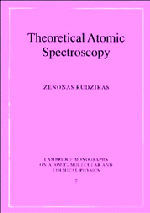Book contents
- Frontmatter
- Contents
- Preface
- Foreword to the Paperback Edition
- Introduction
- Part 1 Energy Spectrum of Many-electron Atom. Radiative and Autoionizing Transitions (Initial Formulas)
- Part 2 Foundations of the Angular Momentum Theory. Graphical Methods
- Part 3 Description of Complex Electronic Configurations
- Part 4 Second-quantization in the Theory of an Atom. Quasispin and Isospin
- Part 5 Matrix Elements of the Energy Operator
- 19 The energy of a shell of equivalent electrons
- 20 Interaction energy of two shells in LS coupling
- 21 Semi-empirical methods of calculation of the energy spectra
- 22 Hyperfine structure of the energy spectra, isotopic and Lamb shift
- 23 Quasispin and isospin for relativistic matrix elements
- Part 6 Electric and Magnetic Multipole Transitions
- Part 7 Calculation of Energy Spectra and Electronic Transitions in the Case of Complex Configurations
- Epilogue
- References
- Index
19 - The energy of a shell of equivalent electrons
Published online by Cambridge University Press: 21 September 2009
- Frontmatter
- Contents
- Preface
- Foreword to the Paperback Edition
- Introduction
- Part 1 Energy Spectrum of Many-electron Atom. Radiative and Autoionizing Transitions (Initial Formulas)
- Part 2 Foundations of the Angular Momentum Theory. Graphical Methods
- Part 3 Description of Complex Electronic Configurations
- Part 4 Second-quantization in the Theory of an Atom. Quasispin and Isospin
- Part 5 Matrix Elements of the Energy Operator
- 19 The energy of a shell of equivalent electrons
- 20 Interaction energy of two shells in LS coupling
- 21 Semi-empirical methods of calculation of the energy spectra
- 22 Hyperfine structure of the energy spectra, isotopic and Lamb shift
- 23 Quasispin and isospin for relativistic matrix elements
- Part 6 Electric and Magnetic Multipole Transitions
- Part 7 Calculation of Energy Spectra and Electronic Transitions in the Case of Complex Configurations
- Epilogue
- References
- Index
Summary
Expression of the energy operator in terms of irreducible tensors
While calculating the energy spectra of atoms or ions one ought to be able to find numerical expressions for all terms of the energy operator (e.g. (1.16) or (2.1)) with regard to the wave functions of the system under consideration. The total matrix element of each term of the energy operator in the case of complex electronic configurations will consist of matrix elements, describing the interaction inside each shell (in relativistic case – subshell) of equivalent electrons as well as between these shells. However, as a rule, it is impossible to find directly formulas for the matrix elements of the corresponding operators. For this purpose each operator must be expressed in terms of the so-called irreducible tensors. This will enable us, further on, to find their matrix elements, to exploit very efficiently the mathematical apparatus of the angular momentum theory, second-quantization as well as the methods of the coefficients of fractional parentage (CFP) and the irreducible tensorial operators, composed of the unit tensors.
In practice, the transformation of any operator to irreducible form means in atomic spectroscopy that we employ the spherical coordinate system (Fig. 5.1), present all quantities in the form of tensors of corresponding ranks (scalar is a zero rank tensor, vector is a tensor of the first rank, etc.) and further on express them, depending on the particular form of the operator, in terms of various functions of radial variable, the angular momentum operator L(1), spherical functions C(k) (2.13), as well as the Clebsch-Gordan and 3nj-coefficients.
- Type
- Chapter
- Information
- Theoretical Atomic Spectroscopy , pp. 219 - 234Publisher: Cambridge University PressPrint publication year: 1997



